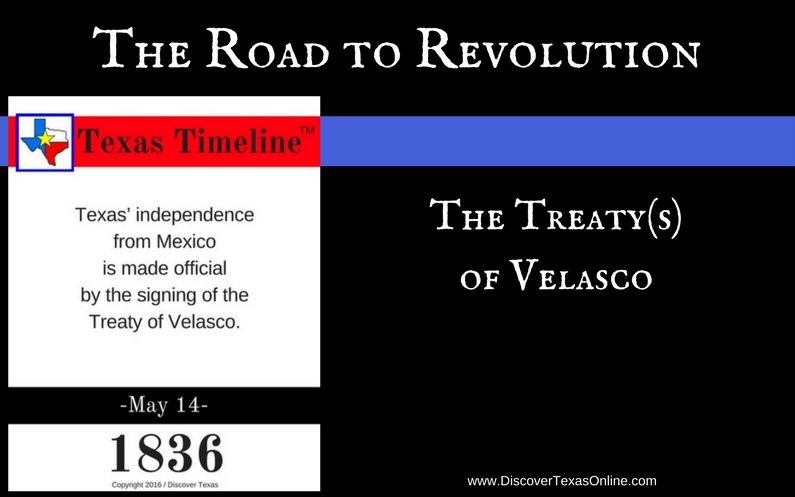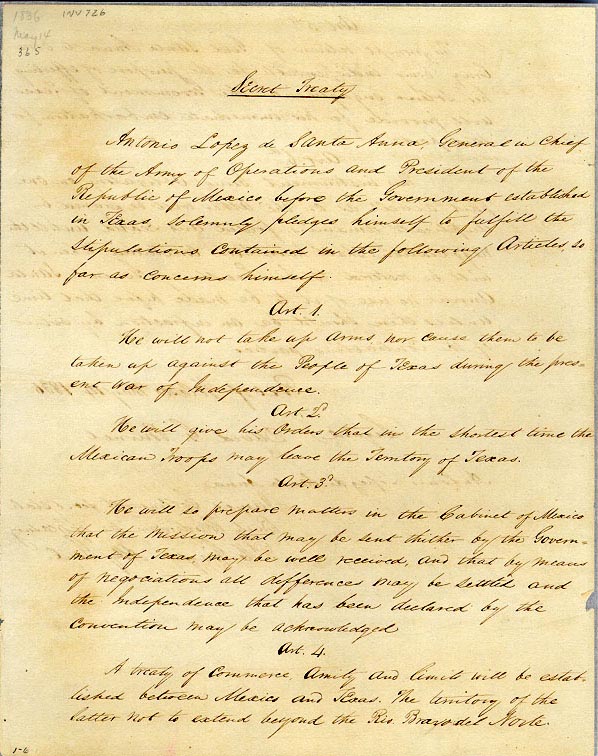
Texas won its independence from Mexico at the Battle of San Jacinto on 21 April 1836. It wasn’t official, though, until 14 May 1836. That’s the day that two treaties were signed in Velasco by David G. Burnet, interim president of the Texas Republic, and Gen. Antonio López de Santa Anna. One was published immediately, but the other was a “secret” treaty.
In the first “public” treaty Texas and Mexico agreed (on paper, anyway) that:
- Hostilities would cease
- Santa Anna would never again take up arms against Texas
- Mexican forces would withdraw beyond the Rio Grande
- Mexico would restore any property it had confiscated
- Prisoners would be exchanged on an equal basis
- Santa Anna (captured as he tried to run away from the Battle of San Jacinto) would be returned to Mexico as soon as possible, and
- The Texas army would not approach the retreating Mexican army any closer than 5 leagues.
In the secret version of the treaty…
- the Texas government promised to free Santa Anna immediately IF he would use his influence to get Mexico’s government to acknowledge Texas as an independent republic
- Santa Anna promised not to take up arms against Texas
- Santa Anna promised to give orders for Mexican troops to leave from Texas
- Santa Anna promised to have his Mexican cabinet receive Texas emissaries favorably
- Santa Anna promised to work for a commerce (trade) treaty, and
- Texas promised that the Texas boundary would not lie south of the Rio Grande.
What good either treaty did, though, is debatable since both sides violated the terms soon after they were signed.
On May 20, the government in Mexico City rejected both treaties. They reasoned that since Santa Anna signed both treaties while a captive, they had been signed under coercion and were therefor void.
Nevertheless, Mexican troops began to withdraw on May 26…but the idea of releasing Santa Anna to an uncooperative Mexican government so soon made the Texas army very nervous. They actively prevented the government of the new Texas republic from carrying out the secret treaty provisions swiftly.
Mexico never recognized Texas independence or the Republic of Texas, nor would they recognize the Rio Grande as Texas’ southern border (even though the Rio Grande had always been considered the dividing line between Texas and Coahuila, Mexico).
When the Republic of Texas sought to join the United States by treaty in 1845, Mexico protested. In an effort to smooth things over through compromise, President Polk offered to purchase any disputed lands between the Nueces River and the Rio Grande, but Mexico flatly refused. The annexation of Texas as the 28th American state went forward, and American troops were sent in 1846 to guard and stabilize the disputed regions. Mexico’s response was to attack the American fort, killing 12 soldiers and capturing about 50 others. This touched off the Mexican-American War, which Mexico (again) lost badly. In the end, Mexico lost not only Texas (and its panhandle extending through Oklahoma as far north as Montana), but also northern California, Utah, Nevada, most of Arizona, and parts of Wyoming, Colorado, and New Mexico!
Teaching Tip:
- Over 180 years later, some factions still insist that the United States “stole” Texas and the Southwest from Mexico. Lead your students in a discussion of trust, terms of treaty, and the consequences of war.



